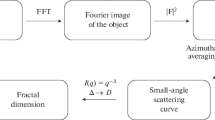Abstract
A two-dimensional elastic fractal tree model is proposed considering the trunk clamped to the ground and extremities under the action of moments. For the proposed problem the normal stress is lower in the trunk and higher in the extremities. The limiting case in which stress is constant in all orders corresponds to the physiological principle of minimum work proposed by Murray (Proc Natl Acad Sci USA 12:207–214, 1926). When longitudinal and transverse proportions coincide the tree is said to be geometrically similar. Geometric similarity, constancy of stress, uniform distribution of elastic energy and of material quantity among orders occur in group. These four states are correlated to each other: the occurrence of two implies that the other two also occur. The proposed approach considers both individual and systemic properties and highlights the inherent connection among them. Flexibility is shown to increase from the trunk to the extremities. Considering a stochastic distribution of external moments the branching design is shown to minimize relative dispersion of stress while concentrating forces through the trunk.



Similar content being viewed by others
References
Barros MM (2011) Fractal dimensions of physical phenomena associated to geometric fractal systems (in portuguese), D.Sc. thesis, Laboratório Nacional de Computação Científica, LNCC, Brazil
Bassingthwaighte JB, Liebovitch LS, West BJ (1994) Fractal physiology. Oxford University Press, Oxford
Bevilacqua L, Barros MM, Galeão ACNR (2008) Geometry, dynamics and fractals. J Brazil Soc Mech Sci Eng 30(1):11–21
Bevilacqua L, Barros MM (2011) Dynamical characterization of mixed fractal structures. J Mech Mater Struct 6:51–69
Benyus JM (1997) Biomimicry: innovation inspired by nature. William Morrow & Company Inc, New York
Dahle GA, Grabosky JC (2009) Review of literature on the function and allometric relationships of tree stems and branches. Arboric Urban For 35(6):311–320
Feder J (1988) Fractals. Plenum Press, New York and London
Kassab GS (2005) Scaling laws of vascular trees: of form and function. Am J Physiol Heart Circ Physiol 290:H894–H903
Mandelbrott B (1982) The fractal geometry of nature. W. H. Freeman and Co., New York
Mauroy B, Filoche M, Weibel ER, Sapoval B (2004) The optimal bronchial tree may be dangerous. Nature 427:633–636
McCulloh KA, Sperry JS, Adler FR (2003) Water transport in plants obeys Murray’s law. Nature 421:939–942
McMahon T (1973) Size and shape in biology. Science 179(4079):1201–1204
Murray CD (1926) The physiological principle of minimum work: I. The vascular system and the cost of blood. Proc Natl Acad Sci USA 12:207–214
Nonnenmacher TF, Losa GA, Weibel ER (1993) Fractals in biology and medicine. Birkhuser Verlag, Basel
Rossitti S, Lofgren J (1993) Vascular dimensions of the cerebral arteries follow the principle of minimum work. Stroke J Am Heart Assoc 24:371–377
Schroeder M (1991) Fractals chaos, power laws. W. H. Freeman and Company, New York
Sherman TF (1981) On connecting large vessels to small: the meaning of Murray’s law. J General Physiol 78:431–453
Thompson D’AW (1971) On growth and form. Cambridge University Press, Cambridge
Zhi W, Ming Z, Qi-Xing Y (2001) Modeling of branching structures of plants. J Theor Biol 209:383–394
Acknowledgments
This work was partially supported by the CNPq (National Research Council) and FAPERJ (Rio de Janeiro Research Foundation) through research projects.
Author information
Authors and Affiliations
Corresponding author
Additional information
Communicated by Fernando Alves Rochinha.
Rights and permissions
About this article
Cite this article
Barros, M.M., Bevilacqua, L. Elastic fractal trees: a correspondence among geometry, stress, resilience and material quantity. J Braz. Soc. Mech. Sci. Eng. 37, 1479–1483 (2015). https://doi.org/10.1007/s40430-014-0288-y
Received:
Accepted:
Published:
Issue Date:
DOI: https://doi.org/10.1007/s40430-014-0288-y




